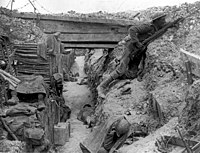
Photo from wikipedia
BackgroundAccounting for subsequent injuries is critical for sports injury epidemiology. The subsequent injury categorisation (SIC-1.0) model was developed to create a framework for accurate categorisation of subsequent injuries but its… Click to show full abstract
BackgroundAccounting for subsequent injuries is critical for sports injury epidemiology. The subsequent injury categorisation (SIC-1.0) model was developed to create a framework for accurate categorisation of subsequent injuries but its operationalisation has been challenging.ObjectivesThe objective of this study was to update the subsequent injury categorisation (SIC-1.0 to SIC-2.0) model to improve its utility and application to sports injury datasets, and to test its applicability to a sports injury dataset.MethodsThe SIC-1.0 model was expanded to include two levels of categorisation describing how previous injuries relate to subsequent events. A data-driven classification level was established containing eight discrete injury categories identifiable without clinical input. A sequential classification level that sub-categorised the data-driven categories according to their level of clinical relatedness has 16 distinct subsequent injury types. Manual and automated SIC-2.0 model categorisation were applied to a prospective injury dataset collected for elite rugby sevens players over a 2-year period. Absolute agreement between the two coding methods was assessed.ResultsAn automated script for automatic data-driven categorisation and a flowchart for manual coding were developed for the SIC-2.0 model. The SIC-2.0 model was applied to 246 injuries sustained by 55 players (median four injuries, range 1–12), 46 (83.6%) of whom experienced more than one injury. The majority of subsequent injuries (78.7%) were sustained to a different site and were of a different nature. Absolute agreement between the manual coding and automated statistical script category allocation was 100%.ConclusionsThe updated SIC-2.0 model provides a simple flowchart and automated electronic script to allow both an accurate and efficient method of categorising subsequent injury data in sport.
Journal Title: Sports Medicine
Year Published: 2018
Link to full text (if available)
Share on Social Media: Sign Up to like & get
recommendations!